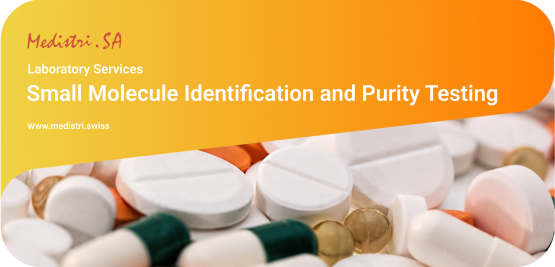(Download: Small Molecule Identification and Purity Testing in PDF by Medistri)
Small Molecule Identification and Purity Testing is essential for a variety of reasons. First and foremost, it ensures the safety of the substances we interact with. Impurities in pharmaceuticals, for example, can lead to adverse effects or diminish the efficacy of the drug. Many industries, especially pharmaceuticals, are subject to strict regulations. Purity testing helps companies comply with these regulations and avoid potential legal issues.
Small Molecule Identification and Purity Testing plays a crucial role in quality control during manufacturing processes - it ensures that the final product is consistent and meets the specified standards.
This process is critical for ensuring that products are safe and effective for their intended uses. There’s also:
Quality Assurance: These tests ensure that the final product is of the highest quality and meets the required specifications. This is crucial in industries such as pharmaceuticals, where the effectiveness of a drug can be compromised by impurities or incorrect formulation.
Safety: Impurities or contaminants in a product can pose significant health risks. Purity testing helps identify any potentially harmful substances that may have been introduced during the manufacturing process.
Regulatory Compliance: Many industries are subject to strict regulations regarding the purity and composition of their products. Regular testing is necessary to demonstrate compliance and avoid potential legal issues.
Product Development: In the research and development phase, these tests can provide valuable insights into how different formulations affect the properties and effectiveness of a product.
Consumer Confidence: Regular testing and quality control can enhance consumer confidence in a product, as it assures them that the product is safe and meets high-quality standards.
The process begins with the collection of a sample from the product. This sample is then subjected to a series of tests designed to identify its chemical composition and purity.
The identification phase involves determining the exact chemical structure of the molecules in the sample. This is crucial because even slight variations in molecular structure can have significant effects on a substance’s properties and potential uses.
The purity testing phase involves determining whether the sample contains any impurities or contaminants. These could be other chemicals that were unintentionally included during production or substances that have entered the product during handling or storage. The presence of impurities can affect the safety and effectiveness of the product, so it’s important to identify and quantify them.
Once the testing is complete, the results are compared against established standards to determine whether the product meets the required specifications. If it does, it can be released for use. If not, further investigation may be needed to identify and address the source of any problems.
Here’s the variety of testing methods used to determine drug substances and products to ensure that final drug products match client specifications:
FTIR Spectroscopy Analysis: FTIR (Fourier Transform Infrared Spectroscopy) is an analytical method for determining, polymeric, biological, or in some cases inorganic compounds.
BPA Testing: Bisphenol A (BPA) is a compound used to make certain polycarbonate materials and epoxy resins. BPA’s are used in a variety of products, including packaging, bottling systems, medical devices, and impact-resistant products. A sample is placed in a closed sampling vessel, heated using a known temperature profile, and the vapor in the vessel is sampled for analysis.
GC/MS Analysis: GC/MS Analysis (also called Gas Chromatography/ Mass Spectrometry) is an analytical process that utilises the capabilities of Mass Spectrometry and Gas Chromatography in order to determine the chemical compounds within a sample. Our laboratory works according to ISO 17025 (current version) and is accredited since 2008 by the Swiss Accreditation Service (SAS). All testing can be performed according to European or US pharmacopeias.
Volatile Organic Compounds (VOCs) Analysis by GC/MS: Volatile organic compounds (also known as VOCs) are compounds that evaporate rapidly from their liquid or solid state into the atmosphere under normal pressure and temperature conditions. VOCs are of concern due to their low boiling points, extensive use, relatively high toxicity, and a high degree of halogenation. ISO 10993-18 focus on chemical characterisation of medical device material within a risk management process. Part of this process is the identification, quantification of extractables and leachable compounds using gas chromatography/mass spectrometry (GC/MS) technology.
PDMS Analysis by FTIR: PDMS analysis by FTIR is a test that consists of extracting and identifying PDMS residues in a qualitative/semi-quantitative method in pharmaceuticals or medical samples. PDMS is optically transparent and, in general, inert, non-toxic and non-flammable - it is one of many types of silicone oil.According to ISO 7886-1, sterile, single-use hypodermic syringes used for medical purposes must not exceed a certain concentration of this type of compound, i.e. 0.025mg/cm2.
Small Molecule Identification and Purity Testing is a critical process in the field of chemistry and pharmaceuticals, ensuring that the substances we interact with are precisely what they are supposed to be, free from impurities, and safe for their intended use. It’s a group of steps that guarantees that the final product is high quality.
🎯 To learn more about Medistri’s Small Molecule Identification and Purity Testing, visit on our website here or directly contact our team at contact@medistri.swiss.
- The Medistri Team
#Medistri
